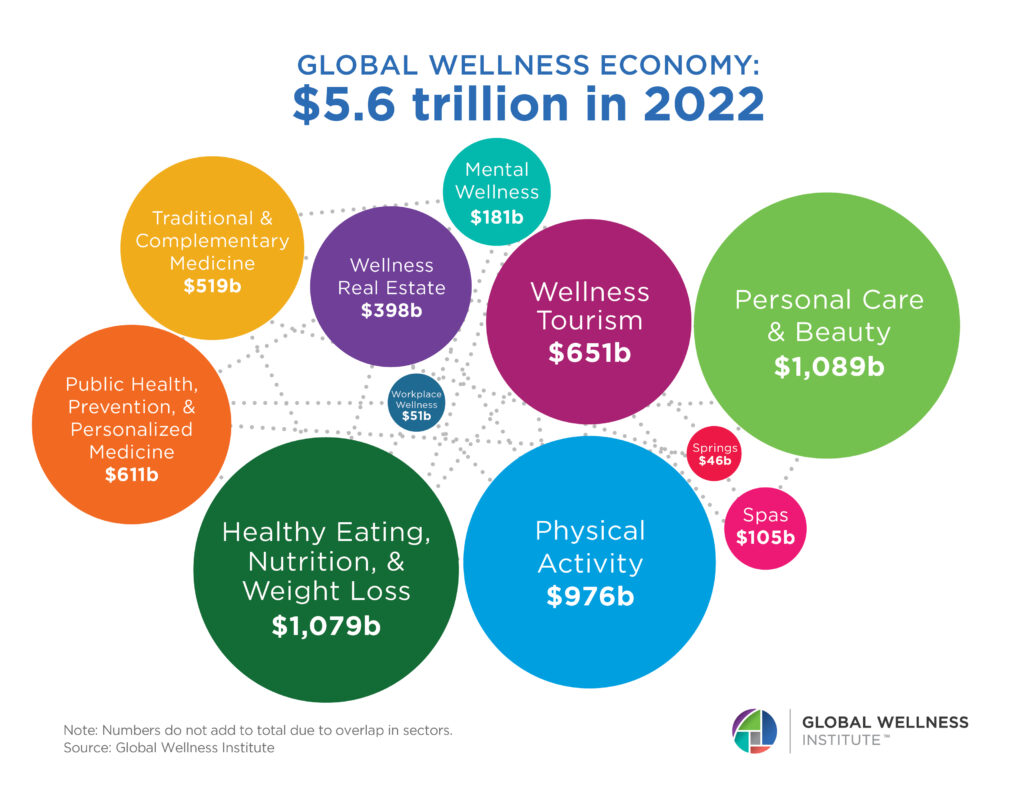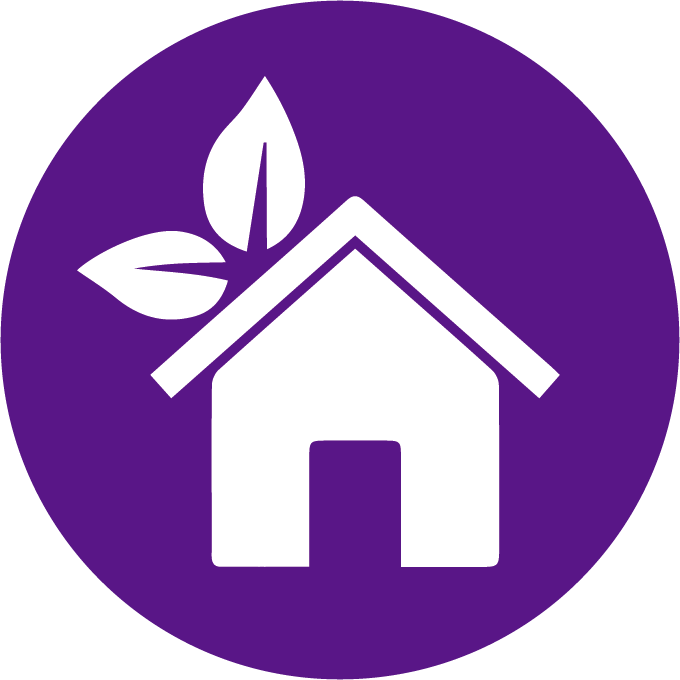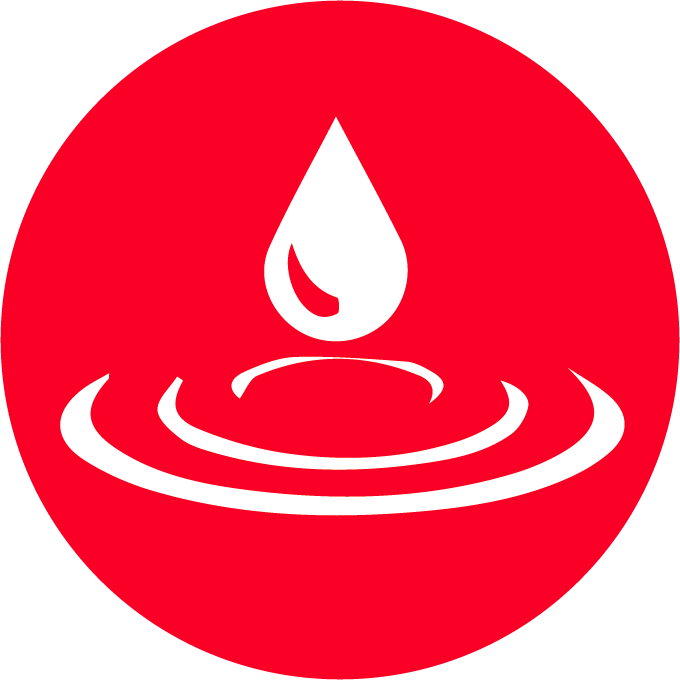Wellness Economy Statistics & Facts
The Global Wellness Institute (GWI) is recognized as the leading source for authoritative wellness industry research. Since 2007, the GWI has commissioned and published numerous research reports on the global wellness economy, including our flagship publication, the Global Wellness Economy Monitor. All reports are available free to the public. Data highlights from recent studies are below. To download all GWI research, including special reports for certain industry sectors and geographic areas, visit Wellness Economy Research.
Global Wellness Economy
GWI is the first and only organization to conduct comprehensive, objective, and global research on the wellness industry. We first defined and measured the wellness economy and its component sectors in 2014, and these figures are updated and released every 2-3 years in the Global Wellness Economy Monitor. Our most recent report, Global Wellness Economy Monitor 2023 (released in November 2023), provides data for 2019-2022.

- The global wellness economy was valued at $4.9 trillion in 2019 and then fell to $4.5 trillion in 2020, due to the massive economic shock of the COVID-19 pandemic. Since then, the wellness economy has recovered quickly. In 2022, the global wellness economy reached $5.6 trillion, nearly 14% higher than its size in 2019.
- As the world continues to recover from the pandemic, GWI predicts that the wellness economy will return to its robust growth. We project 8.6% average annual growth, with the wellness economy reaching $8.5 trillion in 2027.
- The wellness economy represented 5.6% of global economic output in 2022.
The wellness economy includes eleven sectors:
- Personal Care & Beauty ($1,089 billion)
- Healthy Eating, Nutrition, & Weight Loss ($1,079 billion)
- Physical Activity ($976 billion)
- Wellness Tourism ($651 billion)
- Public Health, Prevention, & Personalized Medicine ($611 billion)
- Traditional & Complementary Medicine ($519 billion)
- Wellness Real Estate ($398 billion)
- Mental Wellness ($181 billion)
- Spas ($105 billion)
- Workplace Wellness ($51 billion)
- Thermal/Mineral Springs ($46 billion)
 Wellness Real Estate
Wellness Real Estate
GWI’s 2018 report, Build Well to Live Well, was the first research to size and analyze the global and regional market for wellness lifestyle real estate and communities. The study captures the central role that the built environment plays in driving our health and well-being, and it serves as an extensive resource guide for those seeking more information on how and why to build for wellness. Updated data and analysis for this sector are available in GWI’s latest data report, Global Wellness Economy Monitor 2023.
- Wellness real estate was a $225 billion market in 2019, and it saw explosive growth during the pandemic, reaching $398 billion 2022.
- Wellness real estate has been the fastest-growing sector in the wellness economy since before the pandemic, significantly outpacing projections and economic growth trends. COVD-19 has accelerated the growing understanding among consumers and the building industry about the critical role that external environments play in our physical and mental health and well-being.
- Wellness real estate represented about 3.0% of global annual construction output in 2022.
- GWI estimates that the sales price premiums for wellness residential developments average 10-25% over conventional residential developments.
 Physical Activity
Physical Activity
In 2018, GWI released Move to be Well: The Global Economy of Physical Activity. This report defined and measured six sub-sectors that comprise the vast economy of physical activity: fitness, sports & active recreation, mindful movement, equipment/supplies, apparel/footwear, and technology. Updated data and analysis for this sector are available in GWI’s latest data report, Global Wellness Economy Monitor 2023.
- The physical activity economy reached $876 billion in 2019 and then fell to $747 billion in 2020 (due to the pandemic). It has rebounded quickly in 2020-2022 as people started returning to their regular activities and exercise routines. GWI estimates that physical activity was a $976 billion global market in 2022.
- North America is the largest regional market for physical activity, at $361 billion in 2022.
- Among the three categories of recreational physical activities:
- Sports & active recreation is the largest segment ($265 billion in 2022).
- Mindful movement has been the fastest-growing segment both before and after the pandemic (+16.8% overall increase from 2019-2022), as millions turned to yoga for at-home exercise and stress reduction.
- Fitness was the most negatively impacted during the pandemic, due to gym and fitness center closures, and it has not yet returned to its pre-pandemic level in as of 2022.
- Among the three supporting sectors:
- Sports apparel & footwear is the largest ($372 billion in 2022).
- Fitness technology exploded in 2020 (+22.5% growth), as millions of consumers switched their exercise-related spending to workouts via digital platforms, and it has continued to grow rapidly (+15% average annual growth from 2020-2022).
 Mental Wellness
Mental Wellness
GWI’s 2020 report, Defining the Mental Wellness Economy, was the first study to define and measure mental wellness as a global industry and to identify and benchmark its key sub-segments. Updated data and analysis for this sector are available in GWI’s latest data report, Global Wellness Economy Monitor 2023.
- Mental wellness was first measured as a $130 billion global market in 2019. It grew strongly throughout the pandemic, reaching $181 billion in 2022.
- The United States is the largest market ($87 billion in 2022), followed by China, Canada, Germany, and Japan.
- The mental wellness market encompasses four sub-sectors:
- Senses, spaces, & sleep ($77.3 billion in 2022)
- Brain-boosting nutraceuticals & botanicals ($60.7 billion)
- Self-improvement ($38.3 billion)
- Meditation & mindfulness ($4.3 billion)
 Workplace Wellness
Workplace Wellness
In 2016, GWI released The Future of Wellness at Work. The study provided a broad examination of the current state of wellness in the global workforce, and it presented a new vision for wellness at work, with actions that will help improve workforce health and unleash human potential. The most recent data and analysis for this sector are available in GWI’s latest data report, Global Wellness Economy Monitor 2023.
- Workplace wellness was a $52 billion market in 2019, and it shrank to $48 billion in 2020. Several short-term and long-term structural shifts, in addition to COVID-19, account for the decline in workplace wellness spending in 2020. The sector has rebounded to $51 billion in 2022 but is not yet back to its pre-pandemic level.
- GWI estimates that only 10% of the world’s workers have access to workplace wellness programs and services, mostly concentrated in North America and Europe.
- As the structure of the global workforce changes, fewer workers are in jobs that have access to workplace wellness benefits. In addition, as employers shift toward more holistic approaches for employee well-being, spending on employee wellness becomes more difficult to quantify.
- GWI estimates that workforce unwellness (chronic disease, work-related injuries and illnesses, work-related stress, and employee disengagement) may cost the global economy 10-15% of economic output every year.
 Wellness Tourism
Wellness Tourism
GWI first defined and measured wellness tourism in 2013, bringing attention to the rise of wellness tourism worldwide and defining it as “travel associated with the pursuit of maintaining or enhancing one’s personal well-being.” Our updated 2018 Global Wellness Tourism Economy report provided extensive data and analysis that captured the explosive growth of wellness tourism and its transformation of nearly every aspect of travel. The most recent data and analysis for this sector are available in GWI’s latest data report, Global Wellness Economy Monitor 2023.
- Wellness tourism was one of the fastest-growing wellness economy sectors prior to 2020, but it was also the sector that was most negatively impacted by the COVID-19 pandemic. After peaking at $720 billion in 2019, wellness tourism expenditures plummeted to $351 billion in 2020, due to the pandemic travel bans and border closures around the world.
- Wellness tourism has gradually recovered from 2020-2022, along with the relaxing of pandemic-related travel restrictions and the recovery of the overall tourism market. Wellness tourism reached $651 billion in 2022.
- GWI projects that wellness tourism will grow rapidly in the coming years, as the overall tourism sector continues to recover from the pandemic. Wellness tourism is projected to grow by 16.6% annually, reaching $1.4 trillion in 2027.
- World travelers made over 819 million international and domestic wellness trips in 2019, below the pre-pandemic level of 936 billion trips in 2019.
- International wellness tourists on average spent $1,764 per trip in 2022, 41% more than the typical international tourist. Domestic wellness tourists spent $668 per trip, 175% more than the average domestic tourist.
- Secondary wellness travelers accounted for 88% of wellness trips and 85% of wellness tourism expenditures in 2022. Secondary wellness tourism involves trips where wellness is not the primary motivation for the trip, but where wellness affects some choices and activities because the traveler would like to maintain good health and/or their wellness lifestyle during the trip.
 Spa Industry
Spa Industry
GWI has measured the spa industry at the global, regional, and country levels since 2007. The most recent data and analysis for this sector are available in GWI’s latest data report, Global Wellness Economy Monitor 2023.
- In 2022, there were over 181,000 spas, earning $105 billion in revenues.
- The spa industry was hit hard by the early stages of the COVID-19 pandemic, with travel restrictions, business shutdowns, and stay-at-home orders leading to a 38.6% drop in revenues and a loss of over 5,600 businesses in 2020.
- The ongoing pandemic-related restrictions and tourism decline have continued to affect many spas around the world throughout 2021 and 2022, but nevertheless, the industry has recovered steadily and posted strong revenue growth rates in both years (+22.3% average annual growth). As of 2022, global industry revenues are at 92% of their pre-pandemic peak.
- GWI projects that spa revenues will recover beyond their pre-pandemic levels in 2023 and will reach $156 billion in 2027.
- The top five markets in 2022 were: United States ($25.9 billion), Germany ($7.9 billion), France ($5.0 billion), China ($4.8 billion), and Japan ($4.4 billion).
- The largest categories of spas are hotel/resort spas ($49.0 billion in 2022) and day/club/salon spas ($32.7 billion).
 Thermal/Mineral Springs
Thermal/Mineral Springs
GWI has measured the thermal/mineral springs industry at the global, regional, and country levels since 2013. The most recent data and analysis for this sector are available in GWI’s latest data report, Global Wellness Economy Monitor 2023.
- There are an estimated 31,290 thermal/mineral springs establishments operating in 130 countries.
- As a tourism-dependent industry, thermal/mineral springs was one of the wellness sectors most negatively impacted by the pandemic. The border closures, business shutdowns, and stay-at-home orders effectively decimated business revenues across many regions for much of 2020 and 2021. After a 39% decline worldwide in 2020, business revenues have slowly come back over 2021 and 2022, but are still well below their pre-pandemic peak ($46 billion in 2022, as compared to $66 billion in 2019).
- GWI projects that thermal/mineral springs revenues will recover beyond their pre-pandemic levels in 2024 and will reach $90 billion in 2027.
- GWI estimates that at least 150 new thermal/mineral springs establishments opened from 2020-2022, across every region of the world. At least 42 new projects have already opened or are slated to open in 2023, and over 200 projects are in the pipeline for future openings/development.
- The thermal/mineral springs industry is heavily concentrated in Asia-Pacific and Europe, which together accounted for 94% of industry revenues and 93% of establishments in 2022.
- Top markets include China ($10.2 billion in 2022), Japan ($8.6 billion) and Germany ($6.8 billion).
 Healthy Eating, Nutrition, & Weight Loss
Healthy Eating, Nutrition, & Weight Loss
The most recent data and analysis for this sector are available in GWI’s latest data report, Global Wellness Economy Monitor 2023.
- The healthy eating, nutrition, & weight loss sector grew from $911 billion in 2019 to $1,079 billion in 2022. It is one of the only wellness sectors that has maintained a positive growth trajectory since the beginning of the COVID-19 pandemic.
- GWI cautions that the growth in this sector should not be interpreted as “consumers were eating healthier during the pandemic” – and, in fact, the opposite may be the case. This sector captures spending on certain categories of foods, beverages, and supplements that are labeled and marketed as healthy, but that is not necessarily an indicator of healthy diets.
- The largest sub-sector is healthy-labeled foods & beverages ($874 billion in 2022), followed by vitamins & supplements ($156 billion) and weight loss products & services ($49 billion).
 Traditional & Complementary Medicine
Traditional & Complementary Medicine
The most recent data and analysis for this sector are available in GWI’s latest data report, Global Wellness Economy Monitor 2023.
- Traditional & complementary medicine (T&CM) was a $487 billion market in 2019 and then fell to $450 billion in 2020, due to pandemic business shutdowns and supply chain disruptions that affected retail sales, product manufacturing, and provider visits. The sector has recovered quickly and grew to $519 billion in 2022.
- T&CM services/practitioners represent 54% of the market ($278 billion in 2022), while T&CM medicines/products represent 46% ($240 billion).
- Asia-Pacific is by far the largest regional market for T&CM ($335 billion in 2022).
 Public Health, Prevention, & Personalized Medicine
Public Health, Prevention, & Personalized Medicine
The most recent data and analysis for this sector are available in GWI’s latest data report, Global Wellness Economy Monitor 2023.
- Public health, prevention, & personalized medicine generated $611 billion in spending globally in 2022.
- This sector saw a 50% expansion in size in 2020, due to governments and healthcare systems around the world ramping up their public health and prevention expenditures during the pandemic.
- This sector includes two sub-sectors: public health & prevention ($572 billion in 2022) and personalized medicine ($39 billion).
 Personal Care & Beauty
Personal Care & Beauty
The most recent data and analysis for this sector are available in GWI’s latest data report, Global Wellness Economy Monitor 2023.
- Consumer spending on personal care & beauty was hit hard by the onset of the pandemic, falling by 13.3% from 2019-2020. The sector has recovered quickly, and it reached a new peak of $1,089 billion in 2022.
- The three largest regions for personal care & beauty expenditures are North America ($336 billion in 2022), Europe ($303 billion), and Asia-Pacific ($273 billion).
- On a per capita basis, expenditures are highest in North America ($901 in 2022).
























































